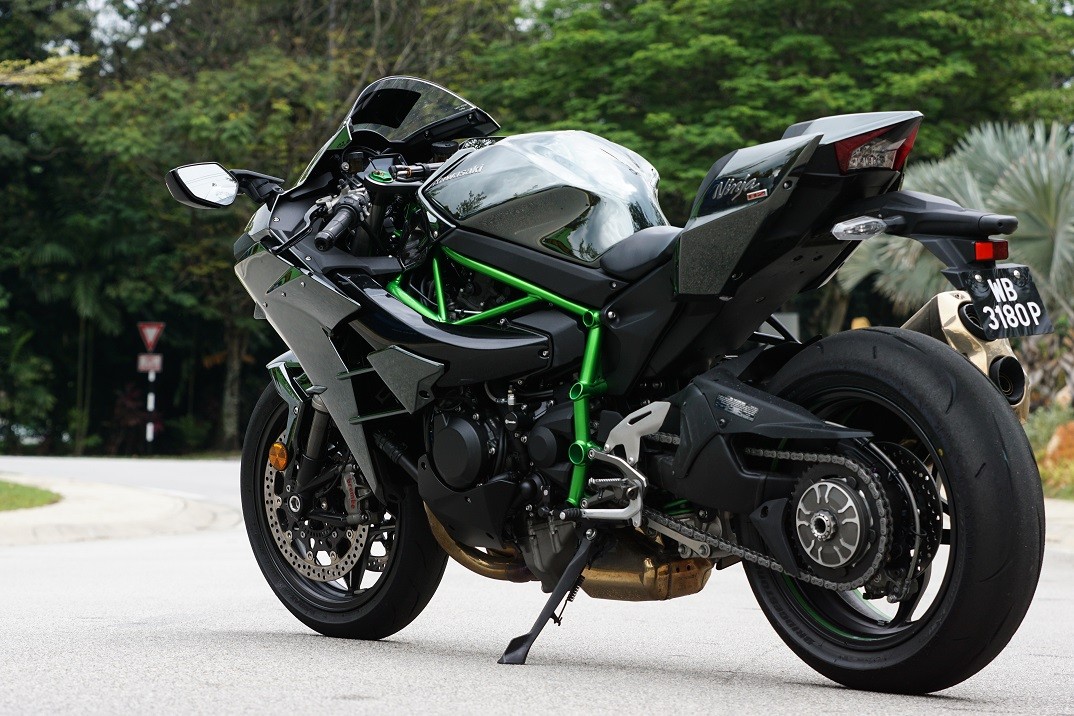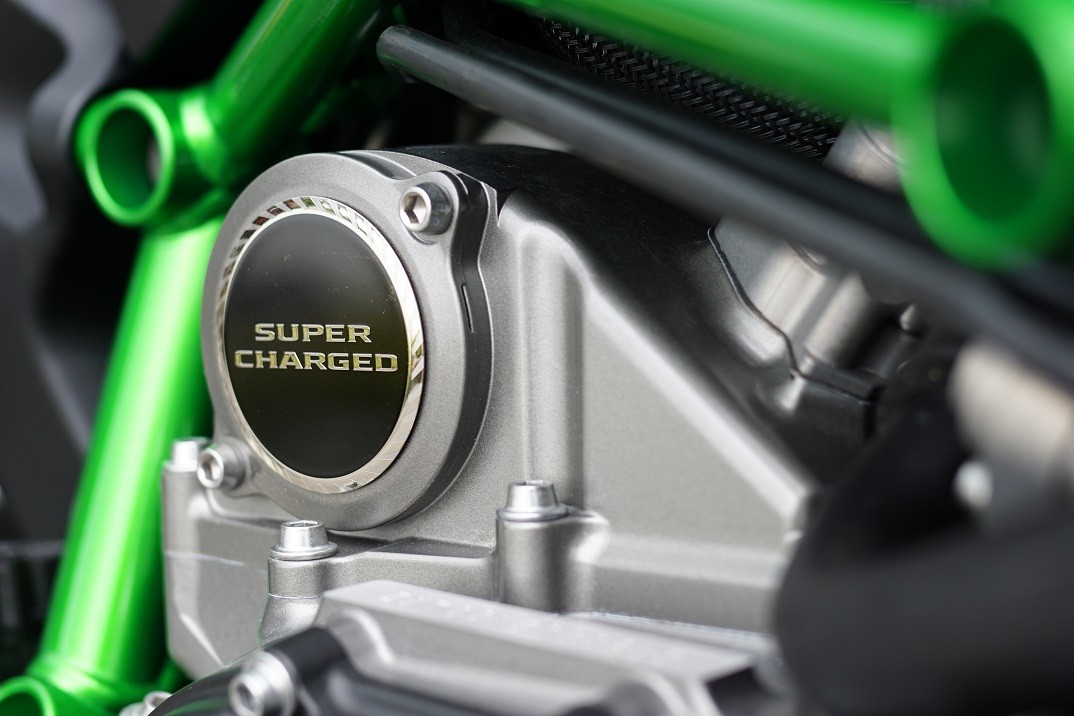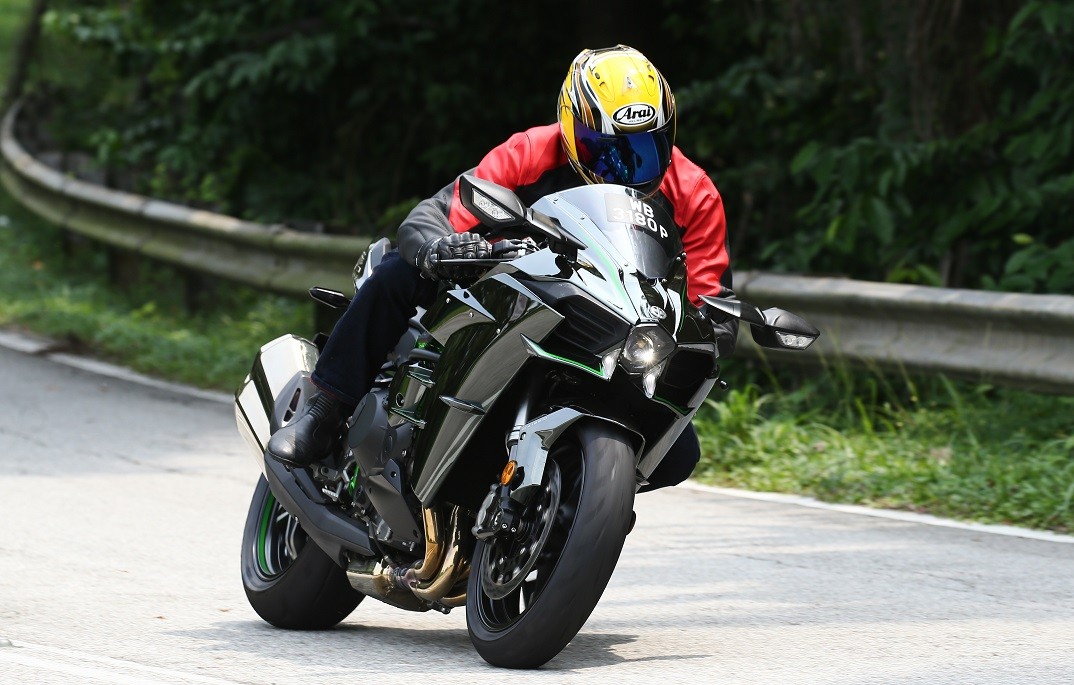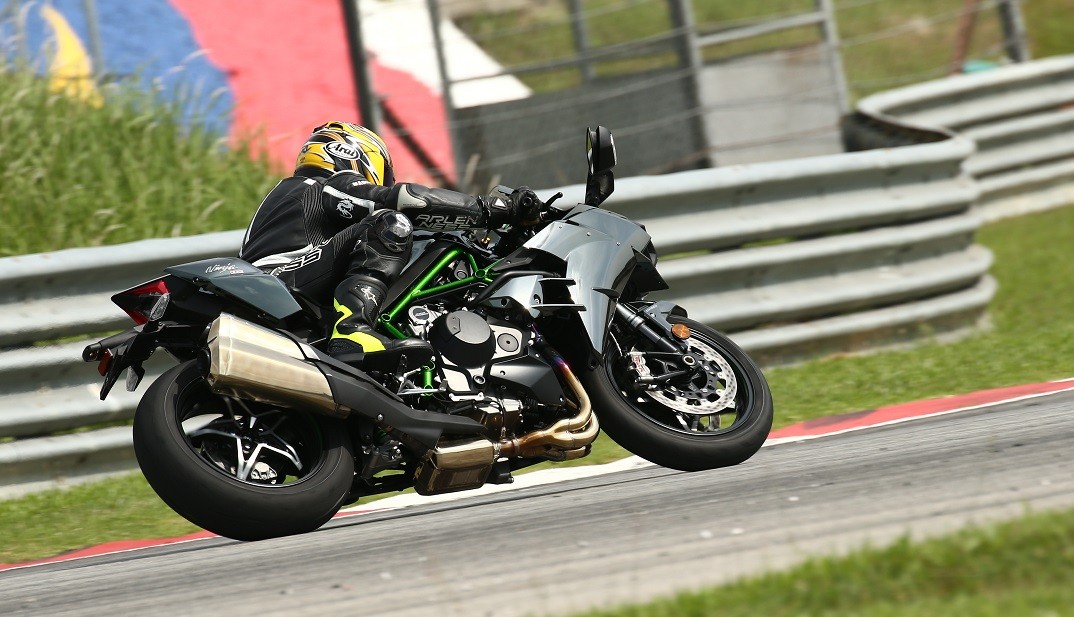Technological demonstrators, halo models and just pure one-upmanship. Call it what you want, history is littered with car and bike companies building super-duper vehicles that broke technological barriers but also broke the bank in the process. The most famous and profligate of them all? The Bugatti Veyron, which reportedly drains €4,617,500 from VW Group coffers every time somebody buys one.
We, however, love these excesses because they’ve resulted in some of the wildest and most memorable cars and bikes in history, which tend to get appreciated later in their lives. The Veyron for instance is now overshadowed by the latest generation of hypercars but twenty years from now, I’d bet the Bugatti would be worth more at a Coys Auction than a McLaren P1 or Ferrari LaFerrari.
There haven’t been a similar number of bonkers bikes because you can only charge so much for a motorcycle before people get turned off. Sure, there have been racer-replicas costing an arm and a leg (Ducati Desmosedici RR, Honda RC30/45) but they were either homologation specials or detuned racers. The only modern day example of when a manufacturer pushed the boundaries with brand new technology was when Honda sold their oval piston wonder the NR. Three hundred of them made it into the hands of the public and these days they go for USD$93,000 and upwards or about double for what they were originally sold for in 1992.
What then will be the future selling price of a Kawasaki H2? It’s undoubtedly the most bonkers road bike ever offered to the general public so how much do we value a straight-laced industrial giant like Kawasaki Heavy Industries (KHI) going nuts?
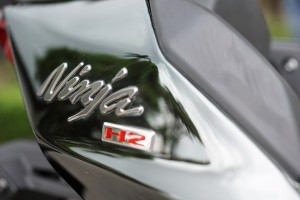 Here’s how we got to this point. When the second decade of the new millennium rolled around, the various subsidiary heads of KHI sat around a table with the chairman and brainstormed a product to showcase the technological abilities of the group. Remember, this is a company that builds ships, high-speed trains, planes, power turbines and stuff that go into outer space, so motorcycles are easy. A bike is however the one product readily accessible to consumers so it was decided to take the best of what they do and distil it into a motorcycle.
Here’s how we got to this point. When the second decade of the new millennium rolled around, the various subsidiary heads of KHI sat around a table with the chairman and brainstormed a product to showcase the technological abilities of the group. Remember, this is a company that builds ships, high-speed trains, planes, power turbines and stuff that go into outer space, so motorcycles are easy. A bike is however the one product readily accessible to consumers so it was decided to take the best of what they do and distil it into a motorcycle.
On the face of it, you have to say a bike like the H2 is akin to Kawasaki unzipping its corporate jeans and putting their 18-inch tackle on the table for a measuring contest. But there is something so wonderful about it you have to be thankful to whomever spiked the sake the night they signed off the project.
What’s so special about the Kawasaki H2? How about everything!
 Let’s start with the bodywork. This isn’t a pretty bike the same way a Ferrari Enzo isn’t a pretty car. The styling was decided by the need to control airflow at speeds exceeding 300km/h and was designed with help from Kawasaki Aerospace. That is why the half fairing has strategically placed winglets, the wing mirror stays are like an aerofoil and there’s a gigantic air intake beside the headlight to feed the engine. See that silver mirror finish paintwork? It’s created by inducing a silver mirror reaction to form a layer of pure silver. This is what gives it a glasslike metal appearance, like how a Terminator T1000 would look if it mimicked a motorcycle. It’s the only finish available for the H2. If you don’t like it, that’s just too bad.
Let’s start with the bodywork. This isn’t a pretty bike the same way a Ferrari Enzo isn’t a pretty car. The styling was decided by the need to control airflow at speeds exceeding 300km/h and was designed with help from Kawasaki Aerospace. That is why the half fairing has strategically placed winglets, the wing mirror stays are like an aerofoil and there’s a gigantic air intake beside the headlight to feed the engine. See that silver mirror finish paintwork? It’s created by inducing a silver mirror reaction to form a layer of pure silver. This is what gives it a glasslike metal appearance, like how a Terminator T1000 would look if it mimicked a motorcycle. It’s the only finish available for the H2. If you don’t like it, that’s just too bad.
The real head turner though is a small bit of shiny metal with the words “Super Charged” printed on it. This signifies the H2 uses forced air induction to not only generate power but to alter your perception of speed forever.
While a supercharged engine is in itself fairly common (though not for bikes), Kawasaki went several steps further. The supercharger for instance was designed in-house with help from the Power Generation, Aerospace and Corporate technology divisions so it’s designed to work perfectly in a motorcycle application and matches the engine characteristics of Kawasaki’s 998cc inline-4 motor. The impeller is machined from a solid billet of aluminium for perfect balance and at full chat, it spins at about 118,000rpm, breaking the sound barrier and pumping in 200-litres of air into the engine per second.
Want more? Polished intake ports and straight exhaust ports allow the gasses to flow efficiently and the exhaust valves are made from Inconel for better heat resistance. That’s the same stuff they used on the tips of the engine cones of the Lockheed SR-71. There are also two injectors per cylinder that spray fuel over stainless steel nets for better atomisation.
With the tech at its disposal, it comes as a bit of a disappointment when Kawasaki says the H2 produces “only” 200hp at 11,000rpm and 133.5Nm at 10,500rpm. On the move with the ram-air induction effect taken into account, it’s good for 210hp, which is impressive but hardly the stuff of legend. For a bike that’ll set you back RM153,900 you have a right to expect more because this is supposed to be the bike that beats all bikes. Then you ride it and your world changes forever.
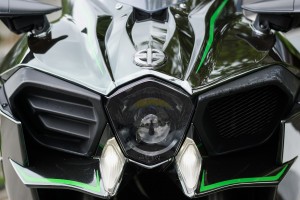 Forget what you think you know about acceleration. Forget what you think was possible for a motorcycle to do. In fact, try and forget just about every reference you’ve ever had about speed, adrenaline and fear when you’ve opened the taps on a fast car or bike. None of it matters. The Kawasaki H2 is shock and awe in a neatly wrapped two-wheeled package.
Forget what you think you know about acceleration. Forget what you think was possible for a motorcycle to do. In fact, try and forget just about every reference you’ve ever had about speed, adrenaline and fear when you’ve opened the taps on a fast car or bike. None of it matters. The Kawasaki H2 is shock and awe in a neatly wrapped two-wheeled package.
From literally any gear, acceleration is of the instantaneous variety, so take a few moments to recalibrate your senses. First and second gear should really be reserved for track days and showing off so serious roll on acceleration commences in third or higher. Even then, at 60km/h with 4000rpm on the counter, you need to make sure the road ahead is empty before cracking open the throttle. When you finally do, the speedometer jumps faster than you can comprehend.
Third gear is dispensed with as you spear deep into three-figure speeds and as the rev lights blink for an up-shift, fourth is grabbed sans clutch using Kawasaki’s first ever quick-shifter system. Rev it out in fifth and you’ll see 270km/h before hitting the 14,000rpm red line and remember, there’s one gear left. Apparently Kawasaki set the speed limiter at 300km/h but it’s a hard limiter, meaning the H2 will feel like it hit a wall as the ignition cuts out to curtail speed. Unhindered, it’s likely to see 320-330km/h or more depending on the size of your brass jewels.
Again, there are loads of other production bikes capable of breaking the triple century barrier; Kawasaki has two of those in the ZX-14R and ZX-10R, but the difference with the H2 is the acceleration never lets up. Like a Shinkansen bullet train, it just goes and goes and goes until the limiter, traffic or your own bravery calls time. As they say in Malay, “Ada berani”?
This leads me to believe Kawasaki is telling a few white lies about the power output. The same engine with a few minor modifications produces in the region of 320hp with ram-air in the track-only H2R, so it either lost 100hp along the way or the figure has been under declared to be politically correct. I guess the last thing KHI needs is pictures of owners appearing on social media giving two-fingered salutes to Ferrari drivers as they blast past with the front wheel in the air.
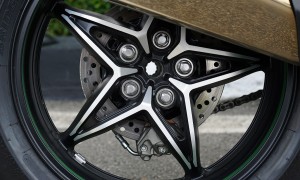 With so much performance on tap, you’d think the H2 would be unmanageable when ridden in city traffic and to be honest there are a few issues. The throttle response for instance is super sharp, especially if you’re in the lower four or five steps of Kawasaki’s 10-step Kawasaki TRaction Control (KTRC) system. Hit a bump and you could add 20km/h if your right wrist flexes. Keep it below 4000rpm and the supercharger really doesn’t deliver too much boost so you do at least have a chance to keep the bike under control at low speed. For ultimate safety, engage rain mode, which softens the throttle response and caps performance by disengaging the supercharger.
With so much performance on tap, you’d think the H2 would be unmanageable when ridden in city traffic and to be honest there are a few issues. The throttle response for instance is super sharp, especially if you’re in the lower four or five steps of Kawasaki’s 10-step Kawasaki TRaction Control (KTRC) system. Hit a bump and you could add 20km/h if your right wrist flexes. Keep it below 4000rpm and the supercharger really doesn’t deliver too much boost so you do at least have a chance to keep the bike under control at low speed. For ultimate safety, engage rain mode, which softens the throttle response and caps performance by disengaging the supercharger.
 Still, all it takes is a bit of clear road to unleash the H2 again. For most bikes and cars, even super fast ones, you eventually get used to the speed but the experience of the H2 with its throttle wound to the stops will never ever get old. Even to experience it for a few seconds will change your life while doing it in sixth gear on a public road requires faith, divine intervention and the ability to disconnect your brain from its self-preservation instincts.
Still, all it takes is a bit of clear road to unleash the H2 again. For most bikes and cars, even super fast ones, you eventually get used to the speed but the experience of the H2 with its throttle wound to the stops will never ever get old. Even to experience it for a few seconds will change your life while doing it in sixth gear on a public road requires faith, divine intervention and the ability to disconnect your brain from its self-preservation instincts.
One thing you get used to though is doing 200km/h plus for extended periods of time. Eventually, even at 150km/h you end up feeling like you could hop off the bike and jog beside it, such is the desensitised feeling of speed but there is actually a price to pay for all this rapid cruising. That comes at the pumps where the 17L fuel tank will barely get you over 160km of riding before the fuel warning lights up. The bike consumes RON97 or Shell V-Power Racing if you want it to run on champagne, so a typical trip to say Penang and back will leave you nearly RM200 out of pocket for fuel alone.
 Keeping all this performance under control is a chassis with a number of firsts for Kawasaki. The frame for instance foregoes the usual twin-spar setup in favour of a steel tube trellis, which offers stiffness but also a degree of flex to cope with the acceleration. A trellis frame also helps dissipate engine heat better due to the large exposed areas of engine block it affords.
Keeping all this performance under control is a chassis with a number of firsts for Kawasaki. The frame for instance foregoes the usual twin-spar setup in favour of a steel tube trellis, which offers stiffness but also a degree of flex to cope with the acceleration. A trellis frame also helps dissipate engine heat better due to the large exposed areas of engine block it affords.
Another Kawasaki first is the single sided rear swing arm, which has the unenviable job of keeping the rear wheel in place as the power and torque try to twist the chassis into a pretzel. Perhaps that’s why it looks like it was taken off a bridge support.
Suspension components are suitably exotic as the front gets a pair of Kayaba AOS-II racing forks, which make their production bike debut. AOS stands for Air-Oil Separate, which gives a smooth free initial action followed by stiffer damping at the bottom of the stroke. The coolest bit is the adjusters for preload, rebound and compression damping housed on the fork tops. They look like they were taken off a racing bike. The rear shock is also fully adjustable and to give it some help in containing the power, the rear tyre is a generous 200mm across. A steering damper is standard while the stoppers are 330mm semi-floating discs grabbed by radially mounted Brembo monobloc callipers at the front, and a 250mm rear disc. ABS is standard.
So the chassis is dripping with high-end exotica, which was needed to keep the engine in check. Get the suspension settings right and the H2 feels compliant over bumps yet has the stiffness to keep the wheels pointing in the same direction when 200hp is dumped on the rear wheel. I would never call it plush and why Kawasaki didn’t adopt electronic damper control (a la BMW’s ESA system) is beyond me, but at least the chassis doesn’t hinder the bike in any way.
Still, on the street, try going quickly on a bumpy road and you’ll feel every rut and pothole you run over. The ride is stiff and though you’d never call it harsh, it means you’ll slow down when the road gets a bit too rough.
The upside to the ride though is precise handling that belies the 238kg kerb weight. You can place the H2 accurately through corners and never worry about losing the front end, though the heroism is more a result of the electronic systems working in unison rather than your own riding skills. You can of course turn off all the electronic nannies and leave your fate in your own hands, but I would strongly suggest against doing that because a high-speed high side on this bike would be epic. Also, a full set of new fairings costs RM28,000, so you really don’t want to hit the deck.
Ultimately, the Kawasaki H2 is a technology demonstrator from KHI that just happens to be the most amazing bike we’ve ever seen. The company is losing money on each unit it sells and though the numbers are no where near as insane as how much the Veyron hits Volkswagen’s coffers, nobody enters business with the aim of losing money. That’s probably why production numbers will be limited and rumours say Kawasaki will build just a few per day on its dedicated production line for one year only. Miss the boat and you can kiss the H2 goodbye.
So, if you want a machine that will accelerate faster than any other production bike or car and be the envy of all your friends, get a Kawasaki H2 and never have another boring ride ever again. Oh…and if you’re nuts enough, get the track-only 320hp H2R to complete the set. It’s utterly bonkers but that’s a story for another day.
Kawasaki Ninja H2
Price RM153,900 (incl. GST)
Engine: 998cc, liquid-cooled, 16v, inline-4
Output 200hp @ 11,000rpm; 133.5Nm @ 10,500rpm
Frame Trellis, high tensile steel
Suspension 43mm USD forks (FF) / New Uni-Trak (RR); fully adjustable
Brakes Twin 330mm floating discs, Brembo Monoblocks (FF), 250mm disc, twin-piston calliper (RR); ABS
Wheelbase 1450mm
Fuel capacity 17L
(Photography by Shukor Janis & VIPhotographer)
